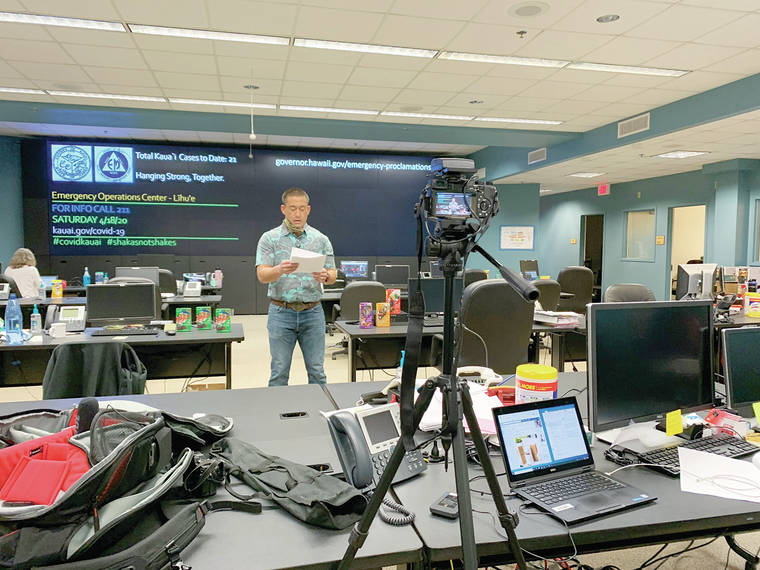LIHU‘E — Since Mayor Derek Kawakami proclaimed an emergency on March 4, the first actions were centered on keeping the count of confirmed cases of COVID-19 on Kaua‘i down, and protecting residents and first responders.
On March 11, the County Council allocated $2 million in emergency funds, and by mid-April about $1.2 million had been spent on a combination of equipment and supplies, social services and labor. At its May 6 meeting, the council extended the availability of these funds an additional 60 days.
According to an expense-tracking form, about $453,653 has been spent on expenditures for supplies in emergency response, like personal protective equipment, N95 masks and sanitization items, as well as computer hardware, data-tracking software and other office-related items.
“The initial response phase of the COVID-19 event focused on containment, mitigation and response,” Kaua‘i Emergency Management Agency Administrator Elton Ushio said in an email. As of May 9, Kaua‘i has reported zero active cases on the island, a number that has held steady for about a month.
On the front lines are those in the Emergency Operations Center, which is made up of trained professionals from KEMA, Kaua‘i Police Department, Kaua‘i Fire Department and additional county departments. EOC staffing is scaled based on need, according to Ushio, and has changed over time throughout the pandemic.
“In general, staffing is between 15 to 30 for the COVID-19 event, with more of a downward trend in recent weeks,” Ushio said in the email.
About $165,049 in expenses has gone toward labor costs like overtime, Social Security, retirement and other mandated benefits for staff across the county Department of Public Works, Office of Economic Development, Transportation Agency and those mentioned above.
“For part of the incident -management team, we made a strategic emphasis on departments to provide labor rather than looking at fire and police, as the only people that work in the Emergency Operations Center,” county Managing Director Michael Dahilig said during the May 6 council meeting. In one instance, there’s an individual with the Agency on Elderly Affairs who works in the fiscal section of the incident-management team.
According to descriptions on the expense report, there have been 60 instances where breakfast and lunch have been bought and expensed, totaling $16,378.79 between March 13 and April 13, for staffers. The majority of these meals have been to local establishments, including Dani’s Restaurant ($5,343.04), Smiley’s Local Grinds ($1,456.31) and Rob’s Good Times Grill ($776.50).
There are no official dates associated with when phases end or when an official reopening can occur, as “decisions are based on risk and science rather than a specific timeline,” Ushio said.
“We can say that the next few weeks will be critical to see how Phase 1 of our recovery/reopening plan might affect our case numbers,” Ushio said. “Obviously, a spike in cases will cause us to take pause and reevaluate. But if we remain steady it puts us in a better position to move forward to Phase 2.”
Operations are rapidly changing, including the loosening of rules, lifting of the curfew and even less frequent COVID-19 update videos from the mayor. What residents have known to be the new normal will continue, like enforcement of isolations, quarantines and contact tracing, as well as traveler screenings, medical testing and providing community assistance.
“Looking to Phase 2 and beyond, KEMA and the county administration is working with and will continue to work with HI-EMA (Hawai‘i Emergency Management Agency), the Governor’s Office, the other counties, and a statewide coalition of governmental and non-governmental partners,” Ushio said.
Going forward, previous overtime can be expected to go down, Dahilig said, and emergency operations should go down “significantly” if there is no spike in cases. And since supplies have been bought, it’s social services that will go up.
What can and will be reimbursed is still to be determined. Dahilig explained that this could come directly from the Federal Emergency Management Agency or from appropriated state funds from the Coronavirus Aid, Relief, and Economic Security Act.
“The only catch is that we cannot use CARES Act money and submit that expenditure to FEMA,” Dahilig said.
•••
Sabrina Bodon, public safety and government reporter, can be reached at 245-0441 or sbodon@thegardenisland.com.




